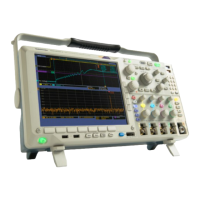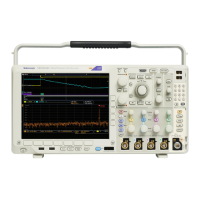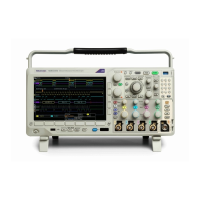Save and Recall I
nformation
Save and Recal
l Information
The oscilloscope provides permanent storage for setups, waveforms, and screen images. Use the internal storage of the
oscilloscope to save setup files and reference waveform data.
Use external storage, such as USB flash drives or network drives, to save setups, waveforms, and screen images. Use the
external storage to carry data to remote computers for further analysis and for archiving.
External file structure. If you are saving information to external storage, select the appropriate menu (such as the To
File side-bezel menu to save setups and waveforms) and turn multipurpose knob a to scroll through the external file structure.
E: is the USB memory device plugged into the first (left) USB port on the front of the oscilloscope
F: is the USB memory device plugged into the second (right) USB port on the front of the oscilloscope
G: and H: are the USB memory devices plugged into the USB ports on the rear of the oscilloscope
I through Z are network storage locations
Use multipurpose knob a to scroll through the list of files. Use the Select front panel button to open and close folders.
Naming yo
ur file.
The oscilloscope gives all files it creates a default name in the following format:
tekXXXXX.set for setup files where XXXXX is an integer from 00000 to 99999
tekXXXXX.png, tekXXXXX.bmp, or tekXXXXX.tif for image files
tekXXXXYYY.csv for spreadsheet files or tekXXXXYYY.isf for internal format files
For waveforms, the XXXX is an integer from 0000 to 9999. The Y YY is the channel of the waveform, and can be one of
the following:
CH1, CH2, CH3, or CH4 for the analog channels
D00, D01, D02, D03, and so on through D15 for the digital channels
MTH for a math waveform
RF1, RF2, RF3, or RF4 for reference m emory waveforms
ALL for a single spreadsheet file containing multiple channels when you select Save A ll Waveforms
For R F traces, XX XX is an integer from 0000 to 9999. The YYY defines the trace and can be one of the following:
NRM for a normal trace
AVG for an average trace
MAX for a maximum hold trace
MIN for a minimum hold trace
AVT for an amplitude versus time trace
FVT for a frequency versus time trace
MDO4000 Series Oscilloscopes User Manual 161

